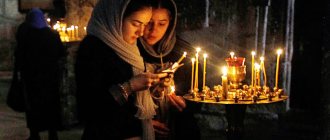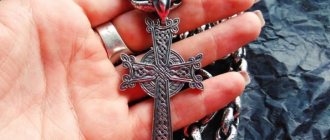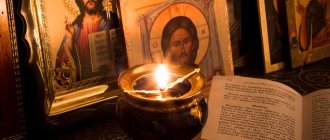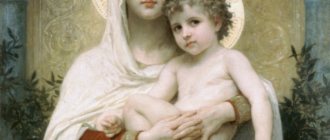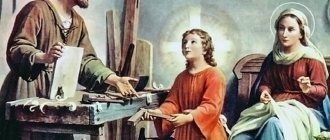Apostles' Creed
I believe in God, the Father Almighty, Creator of heaven and earth.
And in Jesus Christ, His only Son, our Lord, who was conceived by the Holy Spirit, born of the Virgin Mary, suffered under Pontius Pilate, was crucified, died and was buried, descended into hell, rose from the dead on the third day, ascended into heaven and He is seated at the right hand of God the Father almighty, and from there he will come to judge the living and the dead.
I believe in the Holy Spirit, the holy Universal Church, the communion of saints, forgiveness of sins, resurrection of the body, eternal life. Amen.
Common misconceptions about external differences
As a rule, for people who do not particularly delve into the theological subtleties of creeds, the differences between Catholic and Orthodox faiths come down to outwardly obvious nuances. Indeed, there are differences in the conduct of services, the appearance of priests and the arrangement of churches, but not all of them can actually be considered differences.
For example, most people associate the presence of an organ in a church and its use during worship with Catholicism. Meanwhile, in Greece, whose lands are the cradle of Orthodox faiths, the organ is used everywhere.
Very often, when asked what is the difference between Orthodox and Catholic church services, people answer with phrases about how they sit in Western churches and stand in Eastern churches. In fact, this statement is only partially true. In every Orthodox church, there are benches near the walls near the exit from the prayer hall. Every parishioner who needs to sit down has the right to use them. And in churches in Bulgaria it is generally customary to sit during services, just as usual in Catholic churches.
Nicene-Constantinople Creed
I believe in one God, the Almighty Father, Creator of heaven and earth, everything visible and invisible.
And in one Lord Jesus Christ, the Only Begotten Son of God, begotten of the Father before all ages, God from God, Light from Light, true God from true God, begotten, uncreated, consubstantial with the Father; through whom all things were created. For the sake of us, people, and for the sake of our salvation, He came down from heaven, and became incarnate from the Holy Spirit and the Virgin Mary and became Man; crucified for us under Pontius Pilate, suffered and buried, rose again on the third day according to the Scriptures, ascended into heaven and sits at the right hand of the Father, coming again in glory to judge the living and the dead, and of His kingdom there will be no end.
And in the Holy Spirit, the Life-Giving Lord, who proceeds from the Father and the Son, to whom, together with the Father and the Son, befits worship and glory, who spoke through the prophets.
And into one Holy Ecumenical and Apostolic Church. I confess one baptism for the remission of sins. I look forward to the resurrection of the dead and the life of the age to come. Amen.
How did this concept come about?
Creed is a Western term. It was first mentioned in the texts of the Spanish bishop and theologian Ambrose of Milan, who baptized Augustine Aurelius. The bishop used this expression in his message addressed to Sirius I, who occupied the papal throne at that time.
In the Eastern Christian tradition, another concept is accepted - teachings or confessions of faith. However, many theologians, including those belonging to the Orthodox Church, believe that both terms should be used, since they do not contradict one another. The concepts are not completely analogous.
Over time, with the identification of certain church teachings, for example, Anglicanism, the concept of the Creed expanded. Today there are several dogmas of faith, but each of them is based on the Symbols voiced by the disciples of Christ, the apostles. However, the Apostles' Creed was formulated only in the second century. It acted as a counterweight to the spreading ideas of Docetism and was compiled on the basis of the catechism used for the sacrament of baptism at that time.
Afanasyevsky Creed
Anyone who wants to be saved must first of all have the Catholic Christian faith. Anyone who does not keep this faith intact and pure is undoubtedly doomed to eternal destruction.
The Catholic faith is that we worship one God in the Trinity and the Trinity in the One Divinity, without confusing the Hypostases and without dividing the Essence of the Divinity.
For one Hypostasis of the Divine is the Father, another is the Son, and the third is the Holy Spirit. But the Godhead - Father, Son and Holy Spirit - is one, the glory is the same, the majesty is eternal. As is the Father, so is the Son, and so is the Holy Spirit.
The Father is uncreated, the Son is uncreated, and the Spirit is uncreated. The Father is incomprehensible, the Son is incomprehensible, and the Holy Spirit is incomprehensible. The Father is eternal, the Son is eternal, and the Holy Spirit is eternal. Yet they are not three Eternals, but one Eternal. Just as there are not three Uncreated and three Incomprehensible, but one Uncreated and one Incomprehensible.
In the same way, the Father is omnipotent, the Son is omnipotent, and the Holy Spirit is omnipotent. But still there are not three Almighty Ones, but one Almighty One.
Likewise, the Father is God, the Son is God and the Holy Spirit is God. Although they are not three Gods, they are one God.
In the same way, the Father is Lord, the Son is Lord and the Holy Spirit is Lord. Yet there are not three Lords, but one Lord. For just as Christian truth encourages us to recognize each Person as God and Lord, so the Catholic faith forbids us to say that there are three Gods, or three Lords.
The Father is uncreated, uncreated and unbegotten. The Son comes only from the Father, He is not created or created, but begotten. The Holy Spirit comes from the Father and from the Son, He is not created, not created, not begotten, but proceeds.
So there is one Father and not three Fathers, one Son and not three Sons, one Holy Spirit and not three Holy Spirits. And in this Trinity no one is either first or subsequent, just as no one is greater or less than the others, but all three Hypostases are equally eternal and equal to each other.
And so in everything, as was said above, one must worship Unity in Trinity and Trinity in Unity. And anyone who wants to find salvation must reason about the Trinity in this way.
Moreover, eternal salvation requires a firm belief in the incarnation of our Lord Jesus Christ.
For this is righteous faith: we believe and confess our Lord Jesus Christ to be the Son of God, God and Man. God from the Essence of the Father, begotten before all ages; and Man, born from the nature of His Mother in due time.
Perfect God and perfect Man, possessing a rational Soul and a human Body. Equal to the Father in Divinity, and subordinate to the Father in His human essence.
Who, although he is God and Man, is not two, but one Christ. One not because the human essence has turned into God. Completely One, not because the essences were mixed, but because of the unity of the Hypostasis.
For just as the rational soul and flesh are one man, so God and Man are one Christ, who suffered for our salvation, descended into hell, and rose from the dead on the third day; He ascended into heaven, He is seated at the right hand of the Father, God Almighty, from where He will come to judge the living and the dead.
At His coming, all people will rise again bodily and give an account of their deeds. And those who do good will enter into eternal life. Those who commit evil go to eternal fire.
This is the Catholic faith. Anyone who does not sincerely and firmly believe in this cannot achieve salvation. Amen.
What else distinguishes Catholicism from Orthodoxy?
Not only in the view of the afterlife and the words of prayer does it differ, as a set of dogmas, the Creed. Catholic prayer, without a doubt, determines the main spiritual difference, namely, a different perception of the Trinity. However, there is another, very important divergence in doctrines relating to the earthly organization of the Church.
Although the Catholic Creed, as a prayer text, does not mention the position of the Pope, it is still included in the list of immutable truths. In the Western religious tradition, it is customary to consider the Pope to be a priori infallible. Accordingly, every saying of the pontiff is an immutable truth for believers, not subject to dispute or discussion.
In the orthodox tradition, the Patriarch does not have absolute power. In the event that his statements, actions and decisions run counter to Orthodox ideas, the Council of Bishops has the right to deprive the person of his clergy. A historical example of this can be the fate of Patriarch Nikon, who lost his title in the 17th century.
Another noticeable difference between the Churches is the position of ministers. In Orthodoxy, not every clergy implies a person’s renunciation of intimate life. Catholic clergy are bound by a vow of celibacy.
Latin transcription of the prayer
When a foreign text is written in Russian letters, it is not always possible to accurately convey the features of the pronunciation of words. It is recommended to additionally read the Latin version (in the form of transcription). This method makes it easier to understand unfamiliar words. It will be easier to remember them in the future. It is recommended to move on to the Latin transcription after the version written in Russian letters has been studied.
| In Russian | Latin transcription |
| Credo in unum Deum, Patram omnipotentem, factorem celi et terre, visibilium omnium et invisibilium. Et in unum Dominum Iezum Christum, Philium Dei unigenitum, et ex Patre natum ante omnia sekula. Deum de Deo, lumen de lumine, Deum verum de Deo vero, genitum, non factum, consubstantialem Patri, per quem omnia facta sunt. Qui propter nos omines et propter nostram salutem destsendit de tselis. Et incarnatus est de Spiritu Sancto ex Maria Virgina, et omo factus est. Crucifixus etziam pro nobis sub Ponzio Pilato; passus et sepultus est, et resurrexit tertsia die secundum Scripturas, et ascendit in tselyum, sedet ad dexteram Patris. Et iterum venturus est cum glöria yudikare vivos et mortuos, cuius ragni non erith finis. Et in Spiritum Sanctum, Dominum et vivificantem: qui ex Patre protsedit. Qui cum Patre et Filio simul adoràtur et conglerificatur: qui lecutus est per profatas. Et Unam, Saints, Catholics, Et Apostoliks Ecclesiam. Confiteor unum baptisma in remissionem peccatorum. Et expecto resurrectionem mortuorum et vitam venturi seculi. Amen. | Krjédo in únum Djeum, Pátrjem omnipotjéntjem, faktórjem cjéli jet tjérrje, vizibílium ómnium jet invizibílium. Jet in únum Domínum Jjézum Hrístum, Fílium Djéi unigjénitum, jet jeks Pátrje nátum ántje ómnia sjékulja. Djéum dje Djéo, ljúmjen dje ljúminje, Djéum vjérum dje Djéo vjéro, gjénitum, non fáktum, konsubstanciálem Pátri, pjer kvjem ómnia fákta sunt. Kvi próptjer nos óminjes jet próptjer nóstram saljútjem djescjéndit dje cjélis. Jet inkarnátus jest dje Spíritu Sánkto jeks Mária Vírginje, jet ómo fáktus jest. Krucifíksus jéciam pro nóbis sub Póncio Piljáto; pássus jet sjepúl'tus jest, jet rjezurrjéksit tjércia dije sjekúndum Skriptúras, jet ascjéndit in cjéljum, sjédjet ad djékstjeram Pátris. Jet itjérum vjentúrus jest kum gljória judikárje vívos jet mórtuos, kújus rjégni non jérit fínis. Jet in Spiritum Sánktum, Dominum jet vivifikántjem: kvi jeks Pátrje procjédit. Kvi kum Pátrje jet Fílio símul' adorátur jet kongljorifikátur: kvi ljokútus jest pjer prófjetas. Jet únam, sánktam, katólikam jet apostólikam Jekkléziam. Konfítjeor únum baptísma in rjemissiónjem pjekkatórum. Jet jekspjékto rjezurrjekciónjem mortuórum jet vítam vjentúri sjékuli. Amjen. |
Differences between Crucifixions
The cross, as a symbol of faith in the Catholic Church, has a quadrangular shape. Orthodox crosses can have either six or eight corners.
As for the image of the Crucifixion, the main difference is the number of nails. There are three of them on Catholic images, and four on Orthodox images.
Interpretations of the image of Jesus are also different. In the Western tradition, it is customary to depict him naturalistically, as a suffering and dying person. Orthodox images depict Jesus on the cross as triumphant and full of majesty.
Who is baptized how?
The sign of the cross can also be considered one of the symbols of faith, important for every Christian. This is a prayerful, special gesture with which believers call upon themselves or others the blessing of God.
Both Catholics and Orthodox Christians cross themselves with their right hand. In the orthodox tradition, it is customary to perform the sign over the right shoulder. In other words, Orthodox Christians cross themselves from right to left. Catholics do the opposite, making the sign of the cross from left to right.

